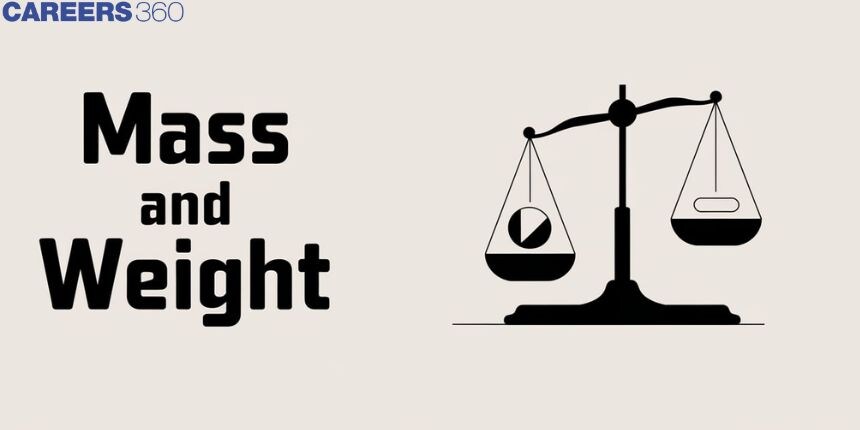Mass and Weight - Definition, Relation, FAQs
When you lift a rice of bag, the bag feels heavy because of its weight, which is the force exerted by the gravity on it. However, the amount of rice in the bag, no matter where you are (Earth, Moon, or space), stays the same. This amount is its mass. But its weight changes on the moon. However, let's understand this concept in detail in the given article.
JEE Main/NEET 2027: Physics Important Formulas for Class 10
NEET 2025: Mock Test Series | Syllabus | High Scoring Topics | PYQs
JEE Main: Study Materials | High Scoring Topics | Preparation Guide
JEE Main: Syllabus | Sample Papers | Mock Tests | PYQs
- What is Mass?
- What is Weight?
- Mathematical Relation Between Mass and Weight
- Difference Between Mass and Weight

What is Mass?
Mass is defined as the amount of matter present in an object. It is a fundamental property that does not change regardless of the location in the universe. The greater the mass of an object, the more matter it possesses.
The S.I. Unit of mass is Kilogram (Kg).
Role in Physics: Mass is a fundamental property of matter and appears in Newton's Second Law of Motion and momentum, $F=m a$,
where,
- $F$ is force
- $m$ is mass
- $a$ is acceleration.
Also read -
- NCERT Notes For All Subjects
- NCERT Solutions for All Subjects
- NCERT Exemplar Solutions for All Subjects
Types of Mass
Mass can be categorized into two types:
- Inertial Mass: Measures an object's resistance to acceleration when a force is applied.
- Gravitational Mass: Determines the strength of the gravitational force exerted by or on the object.
What is Weight?
The force exerted on an object due to gravity is called the Weight of an object. It is a vector quantity meaning it has both magnitude and direction. It changes with the strength of the gravitational field. Unit of Weight is the newton (N), as it is a measure of force.
For example, an object weighs less on the Moon than on Earth because the Moon's gravity is weaker.
Formula to Calculate Weight
$$
W=m g
$$
where $W$ is weight, $m$ is mass, and $g$ is the acceleration due to gravity (approximately $9.8 \mathrm{~m} / \mathrm{s}^2$ on Earth).
Mathematical Relation Between Mass and Weight
The weight ( $W$ ) of an object is directly proportional to its mass $(m)$ and the acceleration due to gravity $(g)$. The formula is:
$$
W=m g
$$
where $W$ is weight, $m$ is mass, and $g$ is the acceleration due to gravity (approximately $9.8 \mathrm{~m} / \mathrm{s}^2$ on Earth).
Difference Between Mass and Weight
The below table shows the difference between the Mass and Weight along with their properties:
|
Property |
Mass |
Weight |
|
Definition |
It is the amount of matter in an object. |
It is the force due to gravity acting on an object. |
|
Nature |
Scalar |
Vector |
|
Unit |
Kilogram (Kg) |
Newton (N) |
|
Dependence |
Independent of Gravity |
Dependent on Gravity |
|
Measurement Tool |
Balance |
Spring Scale |
Frequently Asked Questions (FAQs)
Mass cannot and should not be destroyed or created. However, it can even be changed from shape to every other shape.
For example, the quantity of reactants in chemical reactions is same and equal to the magnitude of the given products produced in that way.
No result.
When the volume increases, the weight remains constant.
For example, If I have weights weighing three gms. The atoms inside this steel (metal) are tightly bound to each other and usually the volume (extend) of every atom is only two inches. Now when I heat this metal, the volume of each atom increases to 3 cubic centimeters while the size does not change i.e., 3 gms.
Photons are traditionally said to be massless. Photons are the smallest measure of light, and no, they don't have mass. Light is composed of photons, which have no mass, so therefore light has no mass and cannot weigh anything.
A measure of the amount of matter contained in or constituting a physical body. Mass is the amount of matter or substance that makes up an object. It is measured in units called kilograms,
Also Read
26 Nov'24 11:34 AM
18 Nov'24 01:04 PM
12 Nov'24 10:11 PM
12 Nov'24 10:08 PM
26 Sep'24 10:55 AM
26 Sep'24 10:54 AM
25 Sep'24 06:39 PM
25 Sep'24 06:26 PM
25 Sep'24 06:26 PM
25 Sep'24 06:25 PM